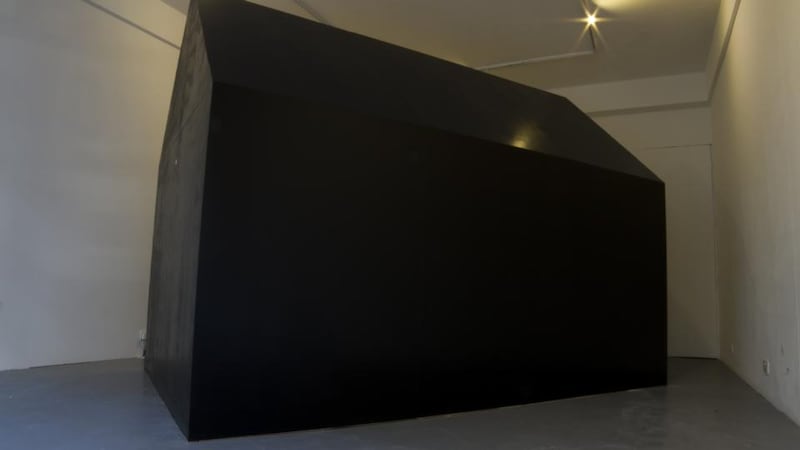Tulca Festival of Visual Arts 2014: Neutral
Various venues, Galway
****


Curator Alison Prior – best-known for her work with Breaking Ground, the ambitious art commissioning programme in Ballymun that took place through much of the first decade of the century – brings a wealth of experience to this year's Tulca. Each year, Galway's winter festival of the visual arts braves the weather and budgetary hurdles and manages to excel. Perhaps because Galway is Ireland's festival capital, there is a lot of local expertise when it comes to putting together professional events. Tulca occupies a brilliant space – central among its several venues – in the former print works of the Connaught Tribune, first used as a gallery by the Galway Arts Festival in July.
The guiding title this year is Neutral, and it is mildly disconcerting to read that the theme, loosely the "anxiety of how to dwell" in the modern world, comes from sociologist and author Richard Sennett. That would be fine, except that it's derived not directly from the horse's mouth but as a quote, "The most difficult thing to learn is how to dwell, without anxiety", tweeted by uber-curator Hans-Ulrich Obrist. Suppose he had tweeted Sartre, instead: "Life is anxiety." We would have quite a different exhibition.
Yet Tulca hasn't entirely embraced Twitter and forsaken the printed word. For one thing, it includes a lengthy, ruminative essay by artist-curator Pádraic E Moore that elucidates the theme perfectly. Moore's text takes the form of a letter to a friend who, echoing Leonard Cohen's Famous Blue Raincoat lyric, has forsaken urban, connected life to build "a little house deep in desolate Connemara". He alludes to Thoreaux's Walden, but also to Ted Kaczynski, the Unabomber, who conducted a prolonged bombing campaign against people he identified with technological modernity, from his cabin in the woods, until he was apprehended in 1996. The little house idea is intriguingly taken up and amplified in the Project Twins' Dwelling at the 126 Gallery on Flood Street.
At Nun's Island Theatre, 2007 Turner Prize-winner Mark Wallinger's 154-minute video Sleeper sees him wandering around a big, deserted house, Berlin's Neue Nationalgalerie, wearing a bear costume. The bear is Berlin's symbolic animal, and sleeper is a term for a deep-cover spy, as during the Cold War, although this sleeper isn't kidding anyone with his disguise. Has anyone apart from the video editor ever sat through all 154 minutes?
It's enough to know that Wallinger put in the hours being a bear. Ten nights, in fact. The average visitor just needs to see a few minutes, which is what most visitors actually devote to videos in art galleries, to get the idea, and it works quite well. Sleeper is odd, funny and sad.
Forms of anxiety are apparent in many pieces. There's an anxiety of materials in Keef Winter's sculpture Mixed Feelings Matter, which jumbles ideas of real and fake, high art and mundane utility, in a calculatedly uneasy work. More overtly, Elaine Leader's walk-through installation induces spatial anxiety quickly and forcefully. Cecilia Danell's Memory Landscapes of the Swedish countryside epitomise the jagged urban-rural, nature-culture overlap characteristic of most of the world we know.
On the other hand, Stephen Gunning's video The Carmelites, which documents the evening prayers of Carmelite nuns and monks in a Paris church, hints at a way of dwelling without anxiety, probably more in a mental than a physical space. And take a close look at Anita Groener's compositions. At first glance abstract, they are in fact composed of myriad individual components that turn out to be intricate silhouettes of human figures. Collectively they make up graceful geometric patterns. They are optimistic works when seen as indicating communal harmony emerging from fractious diversity.
Perhaps one could say the same of Katherine Lamb’s preparatory drawings for the work that will be integral to the new Dún Laoghaire library building. These dense collections of botanical forms in outline are hypnotically absorbing and seem right, probably because the organisms have evolved in response and in relation to their environments.
Tulca's extensive educational component and the advent of the Stir project, a local artists' initiative designed to spur engagement and debate, suggest that it is developing in a useful direction: that is, towards a means of drawing a wider audience into involvement with contemporary art. Until Nov 23, tulcafestival.com
National Self-Portrait Collection Additions 2014
Bourn Vincent Gallery, University of Limerick
****
We live in the age of the self-portrait, but the selfie is a quick fix, a product of throwaway consumer culture. Since 1983, UL has been building a collection of more considered examples of the form, each year inviting a number of contemporary artists to contribute. Flick back through art history and it is evident that the task can be daunting. Look at the efforts of Rembrandt or Van Gogh and it's clear that some real soul-searching is involved.
There's also the question of what form the work will take. For Comhghall Casey, Joe Dunne, Cian McLoughlin, George Potter and Blaise Smith the answer is a straightforward representational likeness in paint, usually oil, with soul-searching evident in each case. In her fine contribution, Nuala Goodman broadens the focus to encompass work and domesticity. Des Farrell opts for his passion for fishing with casts (geddit?) of his hands, while Jason Ellis, who makes fragmentary sculptures, has a limestone carving based on a cast of his right leg. Joe Wilson's composite monoprint sees his head as a landscape. Seán Hillen collages snaps of his head on to images of the first man in space, Yuri Gagarin. Film-maker Vivienne Dick looks calm and reserved in a classically poised photograph. Brian Duggan's stone rendition of an MRI scan of his head, a remarkable piece of work, is probably the cream of the crop. Until Dec 1, ul.ie











